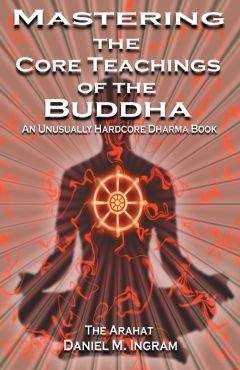Daniel Ingram - Mastering the Core Teachings of Buddha - An Unusually Hardcore Dharma Book
На сайте mybooks.club вы можете бесплатно читать книги онлайн без регистрации, включая Daniel Ingram - Mastering the Core Teachings of Buddha - An Unusually Hardcore Dharma Book. Жанр: Прочее издательство -,. Доступна полная версия книги с кратким содержанием для предварительного ознакомления, аннотацией (предисловием), рецензиями от других читателей и их экспертным мнением.
Кроме того, на сайте mybooks.club вы найдете множество новинок, которые стоит прочитать.

Daniel Ingram - Mastering the Core Teachings of Buddha - An Unusually Hardcore Dharma Book краткое содержание
Mastering the Core Teachings of Buddha - An Unusually Hardcore Dharma Book читать онлайн бесплатно
15
5.THE THREE CHARACTERISTICS
The Three Characteristics are so central to the teachings of the Buddha that it is almost inconceivable how little attention the vast majority of so-called insight meditators pay to them. They are impermane nce , un satisfactori nes s, and no- self . I cannot possibly stress enough the usefulness of trying again and again to really understand these three qualities of all experience. They are the stuff from which ultimate insight at all levels comes, pure and simple. They are the marks of ultimate reality. Every single time I say, “understand the true nature of things,” what I mean is, “understand the Three Characteristics.” To really understand them is to be enlightened.
Somehow this exceedingly important message just doesn't typically seem to get through to insight meditators, and thus they spend so much time doing anything but looking precisely moment to moment into the Three Characteristics. They may be thinking about something, lost in the stories and tape loops of the mind, trying to work on their stuff, philosophizing, trying to quiet the mind, or who knows what, and this can go on for year after year, retreat after retreat, and of course they wonder why they don't have more insight yet. This is a tragedy of monumental proportions, but you do not have to be part of it! You can be one of those insight meditators that knows what to do, does it, and finally “gets it” in the grandest sense.
The big message here is: drop the stories, find a physical object like the breath or body or pain or pleasure or whatever, and look into the Three Characteristics precisely and consistently! Drop to the level of bare sensations! This is vipassana, insight meditation, or whatever you want to call it. It is the way of the Buddhas. All the “opening to it,” “just being with it,” “letting it go” and all of that are quite important, as we will see later, but insight meditators must, repeat, must, look into the following:
IMPERMANENCE
All things are impermane
nt . This is one of the most
fundamental teachings of the Buddha and the second to last sentence he uttered before he died: “All phenomena are impermanent! Work out your salvation with diligence!” In his last words, he said everything you
The Three Characteristics
need to know to do insight practices. Things come and go. Nothing lasts for even an instant! Absolute transience is truly the fundamental nature of experiential reality.
What do I mean by “experiential reality?” I mean the universe of sensations that you actually experience. There are many gold standards for reality. However, when doing insight practices, the only useful gold standard for reality is your own sensate experience. From the conventional point of view, things are usually thought to be there even when you can no longer experience them, and are thus assumed with only circumstantial evidence to be somewhat stable entities.
Predictability is used to assume continuity of existence. For our day-today lives, this assumption is adequate and often very useful.
For example, you could close your eyes, put down this book, and then pick it up again where you left it without opening your eyes. From a pragmatic point of view, this book was where you left it even when you were not experiencing it in any way. However, when doing insight practices, it just happens to be much more useful to assume that things are only there when you experience them and not there when you don’t. Thus, the gold standard for reality when doing insight practices is the sensations that make up your reality in that instant. Sensations not there at that time do not exist, and thus only the sensations arising in that instant do exist. In short, the vast majority of what you usually think of as making up your universe doesn’t exist the vast majority of the time, from a pure sensate point of view. This is exactly, precisely and specifically the point. Knowing this directly leads to freedom.
It is wise to reflect on death and all of that, for it is useful and true.
This is a reflection on ordinary reality and thus an aspect of training in morality that is commonly used to develop motivation to train in insight.
Far better to see one sensation arise and pass away. What do I mean by this? I mean that sensations arise out of nothing, do their thing, and vanish utterly. Gone. Utterly gone. Then the next sensation arises, does its thing, and disappears completely. “That's the stuff of modern physics,” one might say. “What does that have to do with practice?”
It has everything to do with practice! We can experience this, because the first set of vibrations we have access to isn't actually that fast.
Vibrations. That's right, vibrations. That's what this first characteristic 17
The Three Characteristics
means: that reality vibrates, pulses, appears as discrete particles, is like TV snow, the frames of a movie, a shower of vanishing flower petals, or however you want to say it. Some people can get all into complex wave or particle models here, but don't. Just look into your actual experience, especially something nice and physical like the motion and sensations of the breath in the abdomen, the sensations of the tips of the fingers, the lips, the bridge of the nose, or whatever. Instant by instant try to know when the actual physical sensations are there and when they aren't. It turns out they aren't there a good bit of the time, and even when they are there, they are changing constantly.
We are typically quite sloppy about what are physical sensations and what are mental sensations (memories, mental images, and mental impressions of other sensations). These two kinds of sensations actually oscillate back and forth, a back and forth interplay, one arising and passing and then the other arising and passing, in a somewhat quick but quite penetrable fashion. Being clear about exactly when the physical sensations are there will begin to clarify their slippery counterpart that helps create the illusion of continuity or solidity: flickering mental impressions.
Coming directly after a physical sensation arises and passes is a separate pulse of reality that is the mental knowing of that physical sensation, here referred to as “consciousness” (as contrasted with
“awareness” in Part III). By physical sensations I mean the five senses of touch, taste, hearing, seeing, and smelling. This is the way the mind operates on phenomena that are no longer there, even thoughts, intentions and mental images.
Since I just used this dangerous phrase “the mind,” I should quickly mention that it cannot be found. I’m certainly not talking about the brain, which we have never experienced, as the standard for insight practices is what we can directly experience. As an old Zen monk once said to us in his extremely thick Japanese accent, “Some people say there is mind. I say there is no mind, but never mind. Heh, heh, heh!”
However, I will use this dangerous phrase “the mind” often, or even worse “our mind,” but think to yourself when you read it, “He’s just using conventional language, but really there are just utterly transient mental sensations. Truly, there is no stable entity called ‘the mind’
18
The Three Characteristics
which can be found! By doing insight practices, I will fully understand this!” If you are able to do this, we’ll get along just fine.
This mental impression of a previous sensation (often called
“consciousness” in Buddhist parlance) is like an echo, a resonance. The mind takes a crude impression of the object, and that is what we can think about, remember and process. Then there may be a thought or an image that arises and passes, and then, if the mind is stable, another physical pulse.
Each one of these arises and vanishes completely before the other begins, so it is extremely possible to sort out which is which with a stable mind dedicated to consistent precision and to not being lost in stories.
This means that the instant you have experienced something, you know that it isn't there any more, and whatever is there is a new sensation that will be gone in an instant. There are typically many other impermanent sensations and impressions interspersed with these, but, for the sake of practice, this is close enough to what is happening to be a good working model.
Engage with the preceding paragraphs. They are the stuff upon which great insight practice is based. Given that you know sensations are vibrating, pulsing in and out of reality, and that, for the sake of practice, every sensation is followed directly by a mental impression, you now know exactly what you are looking for. You have a clear standard. If you are not experiencing it, then stabilize the mind further, and be clearer about exactly when and where there are physical sensations. Spend time with this, as long as it takes. The whole goal is to experience impermanence directly, i.e. things flickering, and what those things are doesn't actually matter one bit!
How freeing! Interpretation is particularly useless in insight meditation, so you don't have to spend time doing it when you are on the cushion. Throughout this book I recommend reflecting on spiritual teachings and how to bring them to bear on our life, but not on the cushion. Thoughts, even supposedly good ones, are just too slippery and seductive most of the time, even for advanced meditators, though if you can avoid getting lost in their content they are as valid a stream of objects as any other. Try to limit yourself to a few minutes of reflection 19
The Three Characteristics
per hour of meditation. This should be more than enough. There are simply no substitutes for this sort of momentum in practice.
How fast are things vibrating? How many sensations arise and vanish each second? This is exactly what you are trying to experience, but some very general guidelines can provide faith that it can be done and perhaps point the way as well. Begin by assuming that we are talking about one to ten times per second in the beginning. This is not actually that fast. Try tapping five to ten times per second on a table or something. It might take two hands, but it's manageable, isn't it? You could obviously experience that, couldn't you? That's the spirit!
There are faster and slower vibrations that may show up, some very fast (maybe up to forty times per second) and some very slow (that are actually made up of faster vibrations), but let's just say that one to ten times per second can sometimes be a useful guideline in the beginning.
Once you get the hang of it, the faster and slower vibrations are no big deal. Alternately, depending on how you practice, conceiving of this as like a shower of raindrops, a pointillist painting in motion, or 3D TV
snow might help. Reality is obviously quite rich and complex, and thus the frequencies of the pulses of reality can be somewhat chaotic, but they actually tend to be more regular than you might expect. Also, there are not really any “magic frequencies.” Whatever frequency or pulse or whatever you are experiencing at that moment is the truth of that moment! However, in the beginning you should go for faster vibrations over slower ones and then try for wider ones over those that are narrower.
Don't worry if things look or feel solid sometimes. Just be with the solidity clearly and precisely, but not too tightly, and it can start to show its impermanence. Be aware of each exact moment in which you experience solidity and its beginning and ending. Remember that each experience of solidity is a separate, impermanent sensation! Many people begin practicing and really want to solidify something like the breath so that they can actually pay attention to it. They become frustrated when they have a hard time finding the breath or their body or whatever. The reason they can’t find it is not because they are a bad meditator but because they are having direct insight into how things actually are! Unfortunately, their theory of what is supposed to happen 20
The Three Characteristics
involves really perceiving something solid and stable, so they get very frustrated. You should now be able to avoid a lot of that frustration and begin to appreciate why knowing some theory is important.
It is also worth noting here that the frequency or rate of these vibrations may change often, either getting faster or slower, and that it is really worth trying to see clearly the beginning and ending of each vibration or pulse of reality. These are actually at least two different sensations! It is also useful to check out exactly what happens at the bottom, middle, and top of the breath if you are using the breath as an object, and to examine if the frequency stays stable or changes in each phase of the breath. Never assume that what you have understood is the final answer! Be alert! Explore carefully and precisely with openness and acceptance! This is the door to understanding.
One last thing about vibrations: looking into vibrations can be a lot like any other sport. It can be thought of the way we might think of surfing or playing tennis, and this sort of game-like attitude can actually help a lot. We're “out to bust some vibrations!” as a friend of mine enthusiastically put it. You don't know quite what the next return or wave is going to be like, so pay attention, keep the mind on the pulse of the sensations of your world just as you would on the wave or ball, and keep playing!
I highly recommend this sort of speed in practice not only because that is how fast we have to perceive reality in order to awaken, but also because trying to experience one to ten sensations per second is challenging and engaging. Because it is challenging and engaging, we will be less prone to getting lost in thoughts rather than doing insight practices. Our minds have the power to perceive things extremely quickly, and we actually use this power all the time to do such things as read this book. You can probably read many words per second. If you can do this, you can certainly do insight practices.
If you can perceive one sensation per second, try for two. If you can perceive two unique sensations per second, try to perceive four. Keep increasing your perceptual threshold in this way until the illusion of continuity that binds you on the wheel of suffering shatters. In short, when doing insight practices, constantly work to perceive sensations arise and pass as quickly and accurately as you possibly can. With the 21
The Three Characteristics
spirit of a racecar driver who is constantly aware of how fast the car can go and still stay on the track, you are strongly advised to stay on the cutting edge of your ability to see the impermanence of sensations quickly and accurately.
I will relate four of the many little exercises that I sometimes do that I have found useful for jump-starting and developing insight into impermanence. They will demonstrate how we can be creative in exploring our reality precisely but hopefully they will not be thought of in some sort of dogmatic way. These objects and postures are not that important, but understanding impermanence directly is.
In one of these exercises, I sit quietly in a quiet place, close my eyes, put one hand on each knee, and concentrate just on my two index fingers. Basic dharma theory tells me that it is definitely not possible to perceive both fingers simultaneously, so with this knowledge I try to see in each instant which one of the two finger’s physical sensations are being perceived. Once the mind has speeded up a bit and yet become more stable, I try to perceive the arising and passing of each of these sensations. I may do this for half an hour or an hour, just staying with the sensations in my two fingers and perceiving when each sensation is and isn’t there. This might sound like a lot of work, and it definitely can be until the mind settles into it. It really requires the concentration of a fast sport like table tennis. This is such an engaging exercise and requires such precision that it is easy not to be lost in thought if I am really applying myself. I have found this to be a very useful practice for developing concentration and debunking the illusion of continuity. You can pick any two aspects of your experience for this exercise, be they physical or mental. I generally use my fingers only because through experimentation I have found that it is easy for me to perceive the sensations that make them up.
Похожие книги на "Mastering the Core Teachings of Buddha - An Unusually Hardcore Dharma Book", Daniel Ingram
Daniel Ingram читать все книги автора по порядку
Daniel Ingram - все книги автора в одном месте читать по порядку полные версии на сайте онлайн библиотеки mybooks.club.




